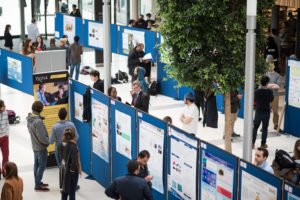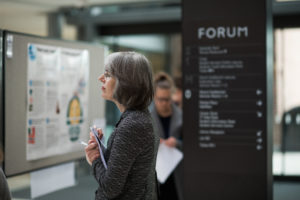Academia is an institution predicated on convention. The choreography of our words, actions and – dare I say it – ‘outputs’ is implicitly shaped by the historical establishment. As well, of course, as by contemporary agendas: the need to publish; to be measurable; impactful; REFable. Typically, we operate in sentences and paragraphs, charts and graphs, chapters or papers. Images are often secondary, whilst for some they are a seemingly unaffordable luxury.
The academic poster is a form of knowledge communication which explodes the boundary walls of academic convention, opening up a space for alternative forms of expression. Prose is often ousted, or at least demoted, as shapes and forms, space and image shoulder the semiotic load.
The academic poster is an act of liberation – perhaps even peaceful protest. Not only for the researcher, but for his or her research. In our thesis we all tell the story of our research, except it’s not the story; it is merely a story: the tale we choose to tell as we navigate our way along the doctoral path: through supervision meetings, conferences convening colleagues, and chapter revisions, towards the Mecca to which all PhD students are directed: the successful viva. Subverting the linear constraints of the thesis, the academic poster provides a stage upon which an alternative research narrative may unfold.
It is for the reasons above that I was drawn, some months prior to the submission deadline, to start planning an academic poster for last year’s postgraduate research showcase. I understand the constraints within which we as scholars must operate, and I know how to do so. Yet I am of an academic generation that is hungry for change, for opportunities to express, communicate and engage in the research process in new and innovative ways, a generation that has not been in the game for long enough to believe that change is not possible. The postgraduate researcher showcase provided me with a platform upon which to enact my frustration with the academy simultaneously with my belief in the power and value of alternative mediums of academic expression.
What is more, I don’t know about you, but I have to do a lot of reading and writing as a PhD student. Creating a poster gave me a break from obsessing over paragraph, chapter and thesis structure, as I was forced to think about colour and composition. It also made me feel good knowing that I was creating something that others would be able to engage with without having to burrow into line-crossing, multi-clausal sentences.
Creating an academic poster enabled me to see my research differently. Simple as. It also forced me to think about how to make my research interesting to an audience that isn’t composed of geeky linguists like myself. It required me to take off my academic blinkers and think about my research from a real world perspective. I have benefited from the activity, as has my research. I can’t really comment on the effects it might have had on others, although it did win the prize for most innovative poster, so I must have done something right. Which is interesting in itself, because what I did was cover my poster with actual swatches of wool. And the judges voted for it. Which goes some way to proving the point above: that there is power and value in alternative forms of academic communication.
So my advice would be to do two things: become proficient at operating within the rules, but also know how not to. Disrupt the norms, push the boundaries and challenge conventions, because that, dear colleagues, is what academia is really all about.
Sarah Foxen- College of Humanities
You can view Sarah’s and other winners posters here.



